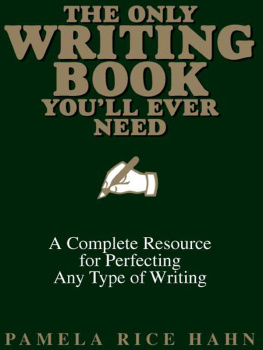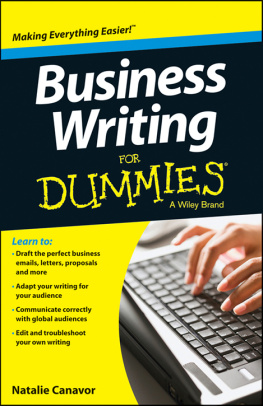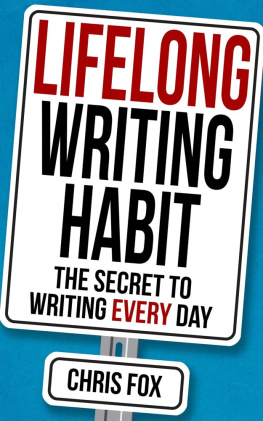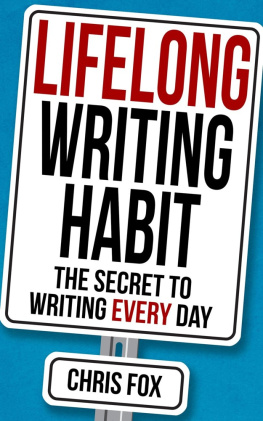Imagine a one-on-one conversation with a communication guru, mentoring, modeling, and motivating you to become a more effective and efficient communicator. You need not imagine, because that guru, Kenneth Davis, has provided those three Ms in The McGraw-Hill 36-Hour Course in Business Writing and Communication, a book that will transform your hope and dreams for improving your writing into the reality of becoming a better writer.
DR. LYLE SUSSMAN
Professor and Chairman, Department of
Management and Entrepreneurship
College of Business
University of Louisville
Coauthor of Smart Moves, Smart Moves for People in Charge,
What to Say to Get What You Want, Yes You Can,
Close the Deal, and Lost and Found
THE
McGRAW-HILL
36-Hour Course
BUSINESS
WRITING AND
COMMUNICATION
SECOND EDITION
Kenneth W. Davis, Ph.D.


Copyright 2010 by Kenneth W. Davis. All rights reserved. Except as permitted under the United States Copyright Act of 1976, no part of this publication may be reproduced or distributed in any form or by any means, or stored in a database or retrieval system, without the prior written permission of the publisher.
ISBN: 978-0-07-174394-5
MHID: 0-07-174394-4
The material in this eBook also appears in the print version of this title: ISBN: 978-0-07-173826-2, MHID: 0-07-173826-6.
All trademarks are trademarks of their respective owners. Rather than put a trademark symbol after every occurrence of a trademarked name, we use names in an editorial fashion only, and to the benefit of the trademark owner, with no intention of infringement of the trademark. Where such designations appear in this book, they have been printed with initial caps.
McGraw-Hill eBooks are available at special quantity discounts to use as premiums and sales promotions, or for use in corporate training programs. To contact a representative please e-mail us at bulksales@mcgraw-hill.com.
TERMS OF USE
This is a copyrighted work and The McGraw-Hill Companies, Inc. (McGraw-Hill) and its licensors reserve all rights in and to the work. Use of this work is subject to these terms. Except as permitted under the Copyright Act of 1976 and the right to store and retrieve one copy of the work, you may not decompile, disassemble, reverse engineer, reproduce, modify, create derivative works based upon, transmit, distribute, disseminate, sell, publish or sublicense the work or any part of it without McGraw-Hills prior consent. You may use the work for your own noncommercial and personal use; any other use of the work is strictly prohibited. Your right to use the work may be terminated if you fail to comply with these terms.
THE WORK IS PROVIDED AS IS. McGRAW-HILL AND ITS LICENSORS MAKE NO GUARANTEES OR WARRANTIES AS TO THE ACCURACY, ADEQUACY OR COMPLETENESS OF OR RESULTS TO BE OBTAINED FROM USING THE WORK, INCLUDING ANY INFORMATION THAT CAN BE ACCESSED THROUGH THE WORK VIA HYPERLINK OR OTHERWISE, AND EXPRESSLY DISCLAIM ANY WARRANTY, EXPRESS OR IMPLIED, INCLUDING BUT NOT LIMITED TO IMPLIED WARRANTIES OF MERCHANTABILITY OR FITNESS FOR A PARTICULAR PURPOSE. McGraw-Hill and its licensors do not warrant or guarantee that the functions contained in the work will meet your requirements or that its operation will be uninterrupted or error free. Neither McGraw-Hill nor its licensors shall be liable to you or anyone else for any inaccuracy, error or omission, regardless of cause, in the work or for any damages resulting there from. McGraw-Hill has no responsibility for the content of any information accessed through the work. Under no circumstances shall McGraw-Hill and/or its licensors be liable for any indirect, incidental, special, punitive, consequential or similar damages that result from the use of or inability to use the work, even if any of them has been advised of the possibility of such damages. This limitation of liability shall apply to any claim or cause whatsoever whether such claim or cause arises in contract, tort or otherwise.
To my fellow members of the Association of Professional
Communication Consultants, especially Dan Dieterich,
Lee Clark Johns, and Barbara Shwom
CONTENTS
ACKNOWLEDGMENTS
For making this edition possible, I thank:
The readers of, and commentors on, my blog at manageyour writing.com, including Mohammed Al-Taee, Adam Freedman, Danielle Ingram, Roy Jacobsen, Delaney Kirk, Norm Leigh, David William Peace, Dwayne Phillips, Brad Shorr, Cheryl Stephens, Matthew Stibbe, Raymond P. Ward, and Joanna Young
My designer, Dean Eller, of DesignMark, Inc., Indianapolis, Indiana
My agent, Paul S. Levine
My team at McGraw-Hill, including Michele Wells, Nancy Hall, and Alison Shurtz
Above all, my wife and partner, Bette Davis
INTRODUCTION: MANAGE YOUR WRITING
In this knowledge economy, writing is the chief value-producing activity. But you may not be writing as well as you could. That may be because you think writing requires a special talent that some people have and some people dont.
In fact, writing is a process that can be managed like any other business process. If you can manage people, money, or time, then you can manage your writing. And you can profit from the results.
This book will give you the tools to becomein the next 36 hoursa more effective, efficient manager of your own writing.
Youll become more effective because youll learn to produce writing that gets things done.
Youll become more efficient because youll learn to produce more effective writing in less time.
How can this magic happen in just 36 hours? Itll happen because youll learn to take the management skills you already have and apply them to the process of writing. Remember, whether or not the word manager is part of your job title, you clearly are a successful manager. Otherwise, you wouldnt have
the money to buy this book,
the position to have somebody else buy it for you,
or the time and initiative to be browsing through it in a bookstore.
Through your experience in business and in life, youve learned to manage: to manage people, to manage money, to manage time. This book will teach you how to use these same skills when you write.
Let me tell you a story. When I was a kid growing up in rural Iowa, there was a local fisherman who had more money than common sense. He always had the newest, most expensive fishing gear, but he didnt always know how to use it.
One fall he decided to take up ice fishing. He ordered the very best cold-weather clothing, the very best portable shelter, the very best ice saw and tackle. The first winter day our local reservoir had frozen over enough, he was out on the ice at dawn. He set up his shelter, sawed his hole in the ice, sat on his new folding stool, and waited.
Three hours passed without even a sign of a fish. The disgusted fisherman was about to call it quits and head home when he saw a teenage kid in faded blue jeans and a faded green Army field jacket head out onto the ice. The kid whacked a hole in the ice with a hammer, baited a hook, and immediately pulled out a nice fish. Within 10 minutes, the kid had a bucketful and turned back for the shore.
The older man yelled for him, but the kid was apparently out of voice range. So the man started walking fast toward him and finally caught up with him at the shore.
Next page









